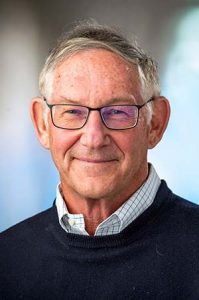The mRNA Vaccine News is Good. But Let’s Keep Masks for Now

Dr. Larry Corey is an internationally renowned expert in virology, immunology, and vaccine development and a leader of the COVID-19 Prevention Network (CoVPN), which was formed by the National Institute of Allergy and Infectious Diseases at the U.S. National Institutes of Health to respond to the global pandemic. He is a Professor of Medicine and Virology at University of Washington and a Professor in the Vaccine and Infectious Disease Division and past President and Director of Fred Hutchinson Cancer Research Center.
[Editor’s Note: a version of this article was first published on the Johns Hopkins University Coronavirus Resource Center. —LT ]
Clinical trials are usually designed to answer one or two specific questions.
For the pivotal COVID-19 trials evaluating messenger RNA vaccines from Pfizer and Moderna, researchers are looking at whether these vaccines prevent a person from getting sick, keep them from suffering a severe, prolonged illness, or keep them from having to be hospitalized.
These are important questions. And the initial trial results are an ironclad demonstration of the power of science. But there are still many more questions we’d like to answer, and more studies will need to be done to allow us to return to a more normal life.
Importantly, these clinical trials are not focused on whether a vaccine boosts immunity to the point that it prevents someone from getting infected with the SARS-CoV-2 virus at all.
It’s possible that a COVID-19 vaccine may benefit the individual who gets vaccinated by protecting them from getting sick. But we know that many people who get infected with the virus can spread it for several days without displaying symptoms, without even knowing they are ill. That means it’s theoretically possible – if not likely – that the virus could invade the body of a vaccinated person, and that vaccinated person might still unwittingly be able to spread the virus to others.
This is a critical distinction that has received little attention.
If you think about it, infecting someone without them knowing it is a great strategy for a virus whose evolutionary goal is to “replicate and survive.”
HIV is a master of this approach. The HIV virus infects most people while causing minimal symptoms. It persists for years before an individual develops the symptoms of AIDS. While the virus is hiding out, unnoticed, the HIV can spread through sexual contact.
SARS-CoV-2 differs from HIV in several ways. For starters, the new coronavirus is most infectious in the first few days after a person has gotten infected. For those first few days, the virus has explosive infectivity — until the body’s immune defense start to kick in against this novel virus it has never seen before.
And, SARS-CoV-2 isn’t transmitted through sex. This virus spreads through much less intimate interactions such as breathing, talking and sneezing around people in your immediate vicinity. This ability to spread through the air makes SARS-CoV-2 way more infectious than HIV. Get close – inches – to someone who’s infected and SARS-CoV-2 is highly contagious. Step a few feet away, and the risk goes down considerably. Wear a mask and it’s a heck of a lot less risky.
So, enter a vaccine. What does it do to this dynamic? Answer… we don’t know yet.
Some of these open questions are quite personal.
People will ask:
If I get vaccinated, do I lessen my risk of actually getting infected? Will I walk around with the virus and not know it?
Do I still shed the virus from my nose, and therefore pose a risk to others if I sneeze? Is my risk of spreading the virus to others reduced by the vaccine, or is it at the same level as if I were not vaccinated at all? How long might the vaccine protect me from getting sick? How long might it keep me from infecting others? Could I be one of those super-spreaders without me knowing that I am sick?
Scientists want to know those answers, because they will be informative for how we adjust our public health response.
If, for example, we have vaccines that are protective against illness, but ineffective against the spread, then we could have a new public health – and communications – challenge.
Imagine if we have hundreds of vaccinated people walking around with the virus unknowingly, behaving with a false sense of security, and yet putting unvaccinated people at an even higher risk of contracting COVID-19?
In medical terms: will vaccinated persons be asymptomatic carriers who can still transmit throughout their household, their community, their school? Will the virus still end up preying on clusters of vulnerable people, like in nursing homes, as it has this year? This is what we call onward transmission.
These questions are of obvious importance. If vaccinated individuals are capable of transmitting infection, then anybody who is not vaccinated faces the same risks of infection as they did before the arrival of the COVID-19 vaccine.
With vaccine hesitancy resulting in fewer people agreeing to be vaccinated, we do not yet know whether and when we will be able to markedly reduce the public health implications of COVID-19 and reduce its circulation in the workplace, in close communities, and stop super-spreading events.
With the promise of a vaccine, many continue to ask: will I still have to wear a mask?
The answer is yes, for now. At least until we know more about infectiousness among the vaccinated.
The way we generally look at a vaccine preventing infection is whether a vaccinated person makes a neutralizing antibody. We want to see increasing levels of those neutralizing antibodies, and for those biological markers to line up with clinical measurements that look at whether people get infected throughout an entire trial. We look at antibodies pre- and post-vaccination to gain this crucial insight into whether the vaccines are doing what they are supposed to do.
We also have tests that determine whether the placebo groups get asymptomatically infected more than the vaccine groups. For example, the most common respiratory virus vaccine – influenza vaccine – sometimes prevents someone from getting a severe case of flu but doesn’t often prevent people from getting infected.
Put differently, one can still acquire the infection even after getting vaccinated. The main goal of most vaccines is to prevent people from getting sick. Preventing a person from getting infected, and therefore preventing them from potentially transmitting the disease, is usually considered to be a higher hurdle to clear.
So, at this point on Nov. 18, we do not know – even with the high efficacy reported in reducing symptomatic disease – whether after vaccination individuals are still infectious. Once a vaccine is widely available, do we still need to be careful about whom we invite to our home for dinner? Do we need to continue to wear masks with other people around, especially casual acquaintances or strangers?
At the moment, the answer is still yes until we unravel these issues.
Mathematical modelers: vaccination and reduction in transmission
Mathematicians have modeled and made predictions about COVID-19, and they have envisioned all sorts of scenarios. And, one scenario they have created imagines that if we have a vaccine that makes everybody asymptomatic, but individuals remain infectious, then whoa! We may actually end up with more people who get infected!
Scenarios like these raise the concern that a lot of people will shrug their shoulders, not get vaccinated, and they will get infected. We will still see a lot of hospitalizations because of COVID-19. There will be more waves of death.
This realization helps explain why we must maximize the number of people in the population who get vaccinated. This requires a concentrated push to overcome vaccine hesitancy, especially in persons who are at high risk. Because we certainly are going to see behavioral changes once people get vaccinated. They’ll think, “I got vaccinated, why do I need to wear a mask?”
So, those modelers, they’ve forewarned us that we do need to learn about infectivity after vaccination.
In the end, to answer the “mask or no mask” question, we need to do a study. That’s where I am today. I’m discussing the issue with colleagues and advocating for a study. Households and college campuses, I think, are a good place to consider for this. These are places where we can vaccinate and sample people every other day and see if they acquire COVID-19. And if they do get vaccinated and give periodic samples, what’s the amount of virus showing up in their noses, their airways, or their bloodstreams?
With that kind of information in hand, we can do some contact tracing to see if people spread it to their roommates and classmates. Colleges are starting to do this anyway. Let’s piggyback on their efforts.
We should do studies that answer the question once and for all: mask or no mask?
Dr. Larry Corey is an internationally renowned expert in virology, immunology, and vaccine development and a leader of the COVID-19 Prevention Network (CoVPN), which was formed by the National Institute of Allergy and Infectious Diseases at the U.S. National Institutes of Health to respond to the global pandemic. He is a Professor of Medicine and Virology at University of Washington and a Professor in the Vaccine and Infectious Disease Division and past President and Director of Fred Hutchinson Cancer Research Center.




